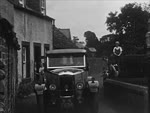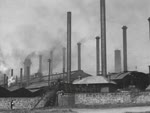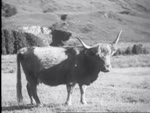FALKIRK

This video is not available to view remotely
Video 1 (currently displayed video)
Full length video - full length available onsite
Video 2
Bookbinding was a very labour-intensive process, many people are involved in creating a finished book from sheets of paper and cardboard in Dunn and Wilson’s bookbinders and printers. (clip)
Please read Understanding catalogue records for help interpreting this information and Using footage for more information about accessing this film.
Title: FALKIRK
Reference number: 1997
Date: 1938
Director: filmed by J.S. Nairn and James Atterson
Sponsor: p.c. Nairatt Production
Sound: silent
Original format: 16mm
Colour: bw
Fiction: non-fiction
Running time: 21.19 mins
Description:
Made as a promotional film for screening at the 1938 Empire Exhibition in Glasgow, it documents the history and industries of the town of Falkirk.
See additional information file.
Credits:
ph. J.S. Nairn
art d. James Atterson
supervision Councillor John Stewart
Shotlist: Credits. Falkirk, like many other Scottish towns, can boast of an historical past. Periodic discoveries show that it was a Pictish settlement of considerable size. Later the Romans had a camp at Camelon on the wall built between the Forth and the Clyde. (.12) Diagram showing the upper and lower terraces of the Roman wall (.20) Scenes at Bantaskine of the remains of the Antonine Wall (.50) In 1298 the first Battle of Fallkirk was fought between the English and the Scots under Sir William Wallace. Nearby is Callendar House which still contains the actual room occupied by Mary Queen of Scots when she visited the district (1.04) ext. shots of Callender House and its gardens, with gardener at work (1.32) Between the first and second Battles of Falkirk, the town was granted its first charter by Charles I in 1646. Prince Charles Edward Stuart was in command of the Highlanders at the second Battle of Falkirk in 1746. After the battle the Young Pretender spent the night at the house of one Mrs. Graham, situated in the High Street (2.01) The steeple, which occupies the site of the Old Tolbooth 1697 (2.05) shots of the steeple and busy town centre including High Street (2.24) The Municipal Buildings and Newmarket Street (2.26) Shots of same (2.46) Cattle in the street being driven from the market (2.51) shot of the Tudor House Restaurant (2.56) Regal Cinema (3.00) The Parish church which stands on the site of the Old Church founded by Malcolm Canmore (3.04) Ext. shots of church and graveyard (3.17) The tomb of Sir John de Graeme (Wallace's greatest friend) who was killed at the first Battle of Falkirk 1297 (3.22) Shot of tomb and of people in the church grounds (3.37) Falkirk today (3.38) general view of the town (3.41) .. is one of Scotland's most progressive towns, having among other things a nursery school (3.45) shots of pre-school children at play outside nursery school supervised by nurses (4.41) shot of sign for burgh of Falkirk public baths (4.46) shot of baths (4.50) shots of women and girls in pool (5.15) Gasworks. Shot of same (5.20) boys playing football with factory in the background (5.27) shot of nurses coming out of health clinic, now the offices of Dunn and Wilson (5.53) prams lined up outside clinic as mothers take their babies in (5.56) babies are examined and weighed (6.41) elecricity generating station. Exterior shots of Corporation Electricity Works (7.00) shots of two posters advising the use of electricity in the home (7.09) A modern fire fighting service. Firemen playing darts and snooker in station (7.17) the alarm sounds and the men rush down to the engine and speed out into the traffic (7.36) In addition to its railway stations, the town has a commodious car park and centrally situated bus station. Shots of car park and attendant (8.02) single and double decker buses make their way to the station, passengers alight and others board (8.29) buses leave station (8.34) Arnotdale or Dollar Park was presented to the town by one of its famous sons, the late Mr. Dollar. Shots in park of ponds, flower beds, statues, aviary, dovecot, monkey in cage, tropical plants in greenhouse, and tree planted by Robert Dollar on 19 March 1924 (10.39) [Out of focus] Inside Aitken's Brewery bottling plant as bottles are labelled, packed in crates and loaded onto trucks (11.28) There are hosiery manufacture, firebrick making, brewing, distilling, chemical manufacture, sawmilling. Timber is unloaded from Forth and Clyde canal then taken to sawmill and machined (12.07) the dressed wood is put in stock (12.15) Wagon building, brass founding, book binding and printing. Men and women at work in Dunn and Wilson's bookbinders and printers (13.09) Box making, tar distilling, aerated water manufacture. shots inside Barr's bottling plant as bottles are washed, filled, capped, packed and loaded onto trucks, all done by women (13.57) Falkirk can truly claim to be the centre of the light casting industry, the first furnace being blown by the Carron Company in 1760. This firm quickly became the chief supplier of heavy ordnance to the arsenals of Europe. Guns used at Waterloo were cast here. Shot of Carron Ironfounders by the Carron dam. Exterior shots men at work and steam engine with trucks in foundry (15.16) The metal used is a mixture of pig iron and scrap. The metal is gathered by giant electro-magnet swinging from crane (16.04) Moulding shop. Man works with moulds (16.54) Some of these castings are not so light, this one weighs 7 1/2 tons! Vat of molten metal is poured into mould (17.39) Dipping pipes as protection against rust. Pipes are dipped and stacked to dry (18.14) Some of the huge stocks of pipes, etc. which are stored ready to meet any order. Shot pipes (18.26) Grinding and polishing. shots of same (18.40) Ingenious machinery is used for tapping and drilling various parts of electric and gas cookers, etc. Shot same (18.57) After buffing and polishing the sections are sprayed or glazed as required. Shots same (19.23) Nimble fingers quickly assemble the various components that go to make up gas and electric cookers. Shot same. Completed fireplaces (20.11) Efficiency is the keynote of the despatch departments of Falkirk's foundries. Items being made ready and loaded lorry leaving (20.59) Falkirk's iron products are transported by road, rail and sea to the ends of the earth and are as well known in the backwoods of Canada as in the backwoods of Australia. Shots of quayside cranes at work at Grangemouth and general view of the docks (21.18) The End (21.19)






